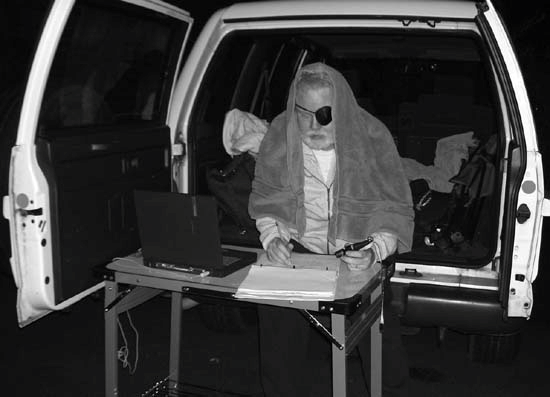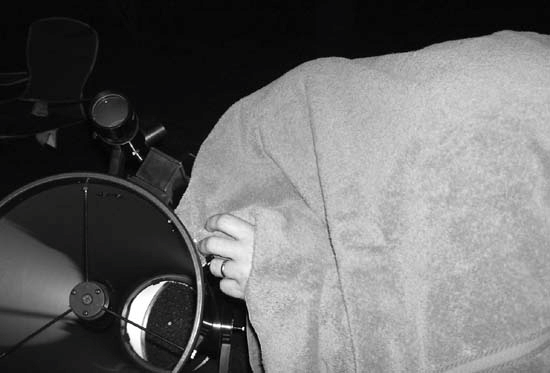Hack12.Protect Your Night Vision from Local Lights
Hack 12. Protect Your Night Vision from Local Lights
Stay dark adapted and keep stray light from the eyepiece (and keep your ears warm). Night vision is all-important when you observe DSOs. For those fortunate enough to have access to a truly dark observing site, it's not difficult to preserve night vision using standard methodsred LED flashlight, covering your notebook computer screen with red film [Hack #44], and so on. But for many astronomers, the only sites within easy driving distance are, at best, semi-dark. The problem with these sites is often not so much general light pollution as local light pollutionthe presence of streetlights and other nearby bright light sources. For example, our regular "dark" observing site routinely offers mag 5.5+ skies, and on good nights mag 6.0 or better [Hack #13]. In terms of general light pollution, that's a respectable DSO observing site, at least by Eastern U.S. standards. Unfortunately, there are half a dozen mercury-vapor lights within a few hundred yards of the site. Their combined light makes it impossible to become fully dark adapted. In fact, it's bright enough to read a newspaper on the observing pad, literally. Because the site is on private property, it is impossible to install permanent screens against the local light pollution. Portable screens are impractical for various reasons. Fortunately, there is a cheap, easy solution to such local light pollution problems, as long as you don't mind looking like a complete idiot. All you need is an old towel and a pirate's eye patch. Figure 2-1 shows Robert working at the chart table, looking like an idiot, but with his night vision intact. Figure 2-1. Robert, fully equipped with eye patch and towel at the chart table… Dark adaptation occurs individually for each eye. That means you can keep one eye completely dark adapted by covering it with the eye patch whenever you are not using it to look through the eyepiece. The other eye is never fully dark adapted, but that doesn't matter. You use it for other purposes, such as locating objects with your notebook computer or charts, or recording observations on your log sheet. For that matter, Robert sometimes uses his "regular" eye to locate objects in the finder and Telrad, for which full dark adaptation is less important. As you prepare to observe an object, position the towel to screen your face and the eyepiece from local light sources and slide the eye patch out of the way. When you finish observing the object, cover your dark-adapted eye with the eye patch before you remove the towel. At particularly bright sites, you may need to use the same procedure when you use the finder or Telrad. Figure 2-2 shows Robert at the eyepiece, using the towel to screen the eyepiece (and his dark-adapted eye) from local light pollution sources. Figure 2-2. …and at the eyepiece If you smoke, as Robert does, you create the worst possible local light pollution problem for yourself every time you click your lighter. Burning tobacco usually isn't bright enough to harm your night vision, but the initial flash of the lighter and the glow as you get the tobacco lit is more than enough to harm your night vision severely, even if you close your eyes as you light up. If you use an eye patch, you may not care about losing the night vision in your regular eye. If you do, try Robert's method, shown in Figure 2-3. Again, it looks stupid, but it works. Just make sure not to light anything except your tobacco. |
EAN: 2147483647
Pages: 112